So you’re interested in mining cryptocurrency, but you’re not sure where to start? No problem, this guide is all you need to set up your own headless litecoin mining rig—even if you have absolutely no experience with this sort of thing.
First, let’s get the obvious question out of the way: why litecoins? After all, bitcoins are worth more, right? The simple answer is that at the time of this writing, litecoins are currently the most profitable cryptocurrency to mine when you take into account how much each coin is worth, and the time required to mine one. Rest assured that if the situation changes, and another cryptocurrency suddenly surpasses litecoin as the best mining option, the rig outlined in the guide should have no problem switching over to a new coin.
This guide will be broken into several parts, each focusing on a different aspect of building your first mining rig. First, let’s take a look at what you’ll need in terms of hardware to put a respectable miner together.
Build your own Litecoin Mining Rig, part 1: Hardware
4/06/2017: This guide is roughly three years old. Please don’t attempt to buy any of the hardware recommended here—it’s quite obsolete! If you’re looking for information about modern GPU mining, please click here for my updated 2017 guide on mining Ethereum.
Here is the list of hardware that I recommend:
| Motherboard | ASRock 970 Extreme4 |
$98 |
| Processor | AMD Sempron 145 |
$38 |
| Memory | 4GB G.SKILL DDR3 SDRAM (2 x 2GB) |
$46 |
| Power Supply | Seasonic 860w Platinum PSU |
$199 |
| GPUs | 3 x MSI Radeon HD 7950 3GB GDDR5 (Twin Frozr) |
$319 each |
| (optional) | 3 x PCI-E riser cable | $5 each |
| (for dummy plugs) | 68 ohm 1/2 watt resistors | $3 |
Update 11/26/2013: The Radeon 7950 video cards are sold out pretty much everywhere. They’re still the best option for mining if you can find them, but if you can’t, then the new Radeon R9 280X cards are likely your best option. They do consume a fair bit more power though, so you”ll want to upgrade your power supply as well (this 1250w Seasonic should support three 280X GPUs without problems). As for brands, I recommend these Sapphire, Gigabyte, and MSI 280X cards for now. I’ll be updating the rest of my guide at some point in the near future with optimal settings for the 280X, so stay tuned.
Update 12/01/2013: If you’re trying to put a rig together, you’ve probably noticed that the above video cards have become nearly impossible to find. I’ve received a few messages from folks that are having some good results using the R9 290 cards, although they’re a fair bit more expensive than the 280X. If you’re itching to build a rig ASAP and can’t find a 7950 or 280X, then you might consider the 290. It looks like all of the current 290 cards are using AMD’s reference cooling design at the moment, so brand probably doesn’t matter too much. Although given a choice, you usually can’t go wrong with Sapphire, Gigabyte, and MSI. Again, remember to pick up a fairly powerful PSU if you’re going to run 3 of these in a rig.
You will also need a USB stick (8GB or larger, this one is fine) if you’re using Linux as your OS, or a harddrive (a cheap SATA drive of any size will do) if you’re using Windows. I will cover setup on both Linux and Windows in the next sections of this guide, as well as the pros and cons of each.
The video cards may be difficult to find, as they’re popular and often sell out. You can substitute nearly any 7950-based GPU, but if you have a choice, go for the MSI or Sapphire cards. They’re not voltage-locked and will save you some electricity in the long run. I have the MSI card that I recommended in all of my rigs, but I’m told that this (and also this) Sapphire card is also a good choice.
The motherboard, CPU, and RAM are all relatively unimportant. The motherboard simply needs to have enough PCI-E slots to host your three GPUs (if the recommended board isn’t available, here is another, or if you can’t find either ASRock, this Gigabyte board is a good alternative). The CPU will essentially sit idle, as all of the actual mining is done by the GPUs. The Sempron 145 is an excellent choice here because it’s cheap and draws very little power (if the Sempron is unavailable, this one is also a fine choice). If you’re going with Linux, you can get away with even less than 4GB of RAM, but I’d stick to that as a realistic minimum on Windows.
The power supply is important, and you don’t want to skimp on it. The Seasonic that I’ve recommended is extremely solid and 93% efficient, which will help keep power consumption to a minimum. It’s also modular, which is really nice if you’re putting this together in a plastic crate like I recommend.
The PCI-E risers aren’t strictly necessary, as all 3 GPUs will fit on the motherboard without them. However, airflow will be extremely limited due to the close proximity of the cards, and I really don’t recommend setting them up that way long-term. The riser cables allow you to position the GPUs off of the motherboard in a more spaced-out fashion. I dropped the temperature of my GPUs by nearly 10 degrees Celcius by simply using risers to separate them. Availability and pricing on Amazon is constantly changing, so check eBay if you can’t find them.
Important: you may also need to create dummy plugs for each of your GPUs. Some operating systems will idle video cards that do not have an active monitor connection, which will obviously kill your mining performance. Dummy plugs “trick” your OS into thinking a monitor is connected, thus preventing attached GPUs from being idled. You just need a few resistors ($1-2 at Radio Shack if they’re not available at Amazon) and these instructions to create your own plugs.
So you’ve got nearly $1400 worth of hardware, but no place to put it, as I haven’t mentioned a case. I highly recommend against trying to cram 3 GPUs into a conventional PC case. A plastic crate or two works far better due to the tremendous heat that the video cards will give off. Added bonus: they’re cheap!
Here is what you’ll need to create a simple DIY plastic crate housing for your miner:
| Plastic Crate |
$5 each |
| Plastic stand-offs | $4 |
| 6 x #4 3/8″ wood or metal screws | $1 |
| Brace to rest GPUs on (I used two of these) | $4 |
| a few cable ties (8″ or so) | $2 |
| power switch & LED (optional) | $6 |
You can get plastic crates in most home improvement stores if you don’t want to ship it from Amazon. I picked mine up at Lowe’s for under $5 each. You should be able to get everything else on the list at Lowe’s if you happen to have one near you, too. As far as tools go, you’ll need a drill and a knife capable of cutting into whatever plastic crate you buy.
Assembly Steps:
First, attach your CPU & heatsink/fan to your motherboard, and place your RAM into the memory slot(s). Then follow the general steps below to mount everything into your plastic crate.
Click the images for a close-up look at each step.
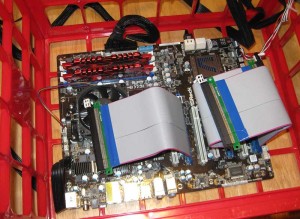 Place plastic standoffs on the bottom of your plastic crate, and rest your motherboard on top of them. Make sure that all of the essential ports are accessible (SATA, USB, keyboard, mouse, etc). Use your knife to cut away pieces of the crate if necessary so that all ports you plan to use are exposed. Then plug your riser cables into the PCI-E slots of your motherboard.
Place plastic standoffs on the bottom of your plastic crate, and rest your motherboard on top of them. Make sure that all of the essential ports are accessible (SATA, USB, keyboard, mouse, etc). Use your knife to cut away pieces of the crate if necessary so that all ports you plan to use are exposed. Then plug your riser cables into the PCI-E slots of your motherboard.
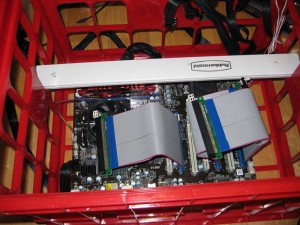 Place your brace (either the plastic guards that I recommended, or a cut yardstick, or whatever you have that works) so that it is sitting above the motherboard, high enough for your GPUs to rest on. Cut the brace so that an inch or two sticks out on either end of the crate.
Place your brace (either the plastic guards that I recommended, or a cut yardstick, or whatever you have that works) so that it is sitting above the motherboard, high enough for your GPUs to rest on. Cut the brace so that an inch or two sticks out on either end of the crate.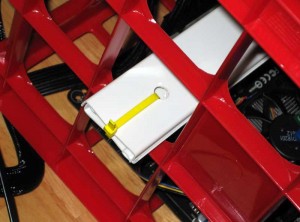 Drill holes in your brace so that you can secure it with cable ties (see image). Do not simply rest the brace on the crate! An accidental bump can cause it to fall into the crate, along with ~$1000 worth of GPUs if you do that!
Drill holes in your brace so that you can secure it with cable ties (see image). Do not simply rest the brace on the crate! An accidental bump can cause it to fall into the crate, along with ~$1000 worth of GPUs if you do that!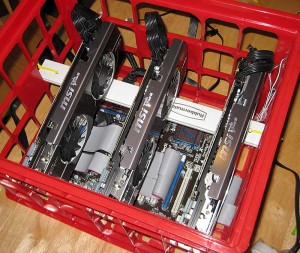 Connect each GPU to it’s corresponding riser cable, resting the bracket end on the lip of the crate and the other end on your brace.
Connect each GPU to it’s corresponding riser cable, resting the bracket end on the lip of the crate and the other end on your brace.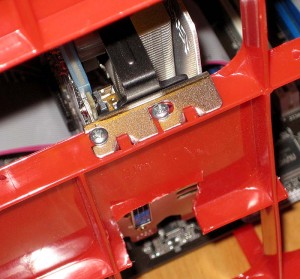 Screw each GPU down into the lip of the crate. If you drill small pilot holes ahead of time (mark where to drill with a sharpie), this is much easier.
Screw each GPU down into the lip of the crate. If you drill small pilot holes ahead of time (mark where to drill with a sharpie), this is much easier.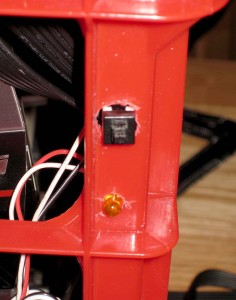 If you have a power switch and LED, mount them into one of the crate’s corners. I was pretty sloppy with mine, but it’s functional.
If you have a power switch and LED, mount them into one of the crate’s corners. I was pretty sloppy with mine, but it’s functional.
You’re done! Simply connect everything to your power supply and you should be ready to power your rig on for the first time. If you have a second crate, you can put your power supply in there (along with your harddrive if you’re using Windows), and stack it under your main crate to save some space.
In the next part of this guide, I’ll show you everything you need to do to start mining under Linux (and Windows will follow shortly after)!



 April 18th, 2013
April 18th, 2013  CryptoBadger
CryptoBadger 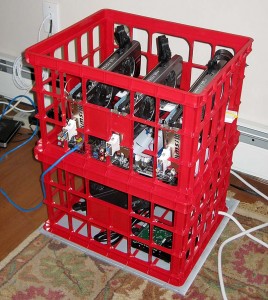
 Posted in
Posted in  Tags:
Tags: 


Are you absolutely sure I dont need 16 gb memory for 4 cards? I heard the sempron doesnt do 4 cards so well either. Also will the Asrock EX4 allow me to run the cards without dummy plug? or is it a windows thing
Yup, if you’re using cgminer, your CPU will pretty much be idle, and your memory will be virtually untouched. There are some less popular miners that use system RAM, but cgminer uses the memory built onto your video cards, so there is no need to buy more than a gigabyte or two for a dedicated GPU miner.
Odds are that you won’t need dummy plugs if you use the hardware and driver versions I recommend in my guide. If you use a different OS version, you may need them.
Thanks CB,
that is a great tutorial!
I’ve build my miner using these writings
with only difference I chose to use the 1600W PSU
and 5 of the GPUs.
Now I have a problem when using all 5 of the MSIs.
It is relatively stable when using 4,
but when using all 5 of them (with 1x/16x powered risers)
one of them has the yellow triangle in Device Manager (DM)
and cgminer doesn’t “see” that card.
I tried different catalyst (vision whatever is called) suite.
Only with version 12.6 I can see all 5 of them in DM,
but then cgminer always starts with one GPU disabled.
I’m considering this is a motherboard design flaw/compatibility issue.
Something like video cards limit or something.
Anyhow, I want to get another AM3+ MB that supports 5 GPUs.
Any ideas? Both how to fix the issue or for a descent 5 GPU motherboard?
What mobo are you using?
ASROCK 970 Extreme4 (from the tutorial)
Maybe this will help…
https://forum.litecoin.net/index.php/topic,5064.msg37415.html#msg37415
I plan on trying for 5 gpu, running ubuntu… sounds like getting the extra cards on can be tricky though. Especially the 5th card. I might just stick with 4. I am still researching…
also this:
https://bitcointalk.org/index.php?topic=257670.0
It sounds like you’re running Windows. Four GPUs is pretty much the limit in Windows – it’s possible to get more than 4 working according to a few people on the bitcointalk forums, but it apparently involves quite a bit of headache and some hacks. I can’t confirm as I’ve never tried it myself.
If you want to run 5 GPUs, I absolutely recommend Linux. There isn’t an artificial limit in Linux, and you shouldn’t have any issues getting 5 GPUs running properly.
13.1 drivers from techpowerup allow more than 4 GPUs in windows
It took my a while to find a bigger grate,
but got one from Goodwill for $0.75.
Hey sir,
I just discovered your blog and want to make your litecoin machine for me.
Can you just tell me how much litecoin you make each day please and what’s your kh/s please?
Sorry for my english, i’m french ^^
At current difficulty, one of the rigs outlined in my guide (~1900 Kh/sec) will make about 2 litecoins per day. You can tweak the rigs to get more than 2000 Kh/sec if you’re willing to deal with the extra heat and power usage that comes with the extra hashrate, but I find that aiming for the low 1900 Kh/sec range seems to provide the best compromise between performance and power consumption/heat generation.
You can more information in my FAQ.
How many watts should be expected from 3 7950’s in the 1900Mh/s range?
Hi,
thanks for all the great info! I have had my rig up for a week with 3 msi 7950’s you recommended hashing @ 600 each no hardware errors system seems perfectly stable.
Here is my question at the wall using a kilowatt I am seeing power use around 860 – 890 watt using the power supply below is this ok? I have been trying to under volt the cards but have not had any success yet?
Corsair Enthusiast Series TX 850 Watt ATX/EPS Modular 80 PLUS Bronze (TX850M)
I see in your next comment that you’re running undervolted so this question is a moot point now, but just in case anyone else is wondering, pull 890 watts at the wall on a 850 watt bronze-rated PSU is indeed safe. Remember that PSUs are rated for how much power they deliver to components, not how much they pull from the wall. Assuming the PSU is 90% efficient (being a bronze model, it’s probably less than that), it will pull about 935 watts at the wall when operating at 100% load.
Hi.
Thank you for this guide. I bought all the hardware listed here, except that I bought 5 MSI gpus and a semsonic 1250W psu. I also bought a larger milk-crate. I set up everything and installed Xubuntu. Initially the milk-crate set-up ran too hot.
So, I bought a metal stackable shoe-rack for $20 from The container store and not only does it run cooler, but also my wife likes the set-up. So if any of you are looking for an alternative rack, consider this
http://www.containerstore.com/shop/closet/shoeStorage/floor?productId=10029306&N=73669
🙂
Everything seems to be running just fine.
At today’s prices, the cost of returning the five 7950 cards and replacing them with only two 7990 cards is the same.
My question is, would I actually gain anything by doing this swapping the 5 7950s for the 7990s (MSI)?
Thank you.
-Temuujin
Nice find on the shoe rack!
I haven’t personally tried building a rig around 7990 GPUs yet, but from what I’ve read, the performance is similar to two 7970s.
Assuming that is the case, then five 7950s should give you better performance than two 7990s, although it’d be pretty close.
Great, might you post pics of your shoe rack setup?
Hi, I would like to know if I can build the Litecoin Mining Rig without buying three GPUs MSI Radeon HD 7950 3GB GDDR5, but buying only one. Is that possible? I don’t have that amount of money right now. And, in future, would I be able to add more GPUs? Thanks
PD: My English may not be very good, I’m Argentinian
Yes, a lot of people start with a single GPU, and then add more as time/money allows. Adding additional GPUs should be as simple just powering your miner off, plugging the new GPU(s) in, and then powering back on. In Windows, everything should be recognized automatically. In linux, you may need to run a simple command to get cgminer to recognize the additional GPUs (
sudo aticonfig --adapter=all --initial).Thanks for the info! I’m using Windows, so, according to you, I won’t have problems as my OS will recognise new GPUs. By the way, the tutorial is great!
This looks great an I’m really interested in building something with the same / very similar specs. Quick Q, I assume you need a monitor so why isn’t it included in the build? Also, could you use a monitor you already have hooked up to another build (gaming)? Could you only have one plugged in at a time? Thank you in advance to all respanses
You’ll only need access to a monitor when setting your rig up for the first time. Once it’s set up, you can disconnect the monitor/keyboard/mouse permanently – whenever you need to access your rig, you’ll simply connect remotely from another computer. So as long as you already have access to a monitor that you can use temporarily when setting your rig up, you don’t need to buy another one.
In the case I build a mining RIG exactly like yours…Will my energy bill increase a lot? The current price for KWatt/h is 0,62490 AR$ (=0.109439579 U$D) I would appreciate if you answer back.
Thanks again
You can use this calculator to figure out your energy costs, and whether or not mining will be profitable for you: http://dustcoin.com/mining
It does not say anything about any screen connected to the rig? How to do this? Im a noob.
No monitor necessary except during your initial setup. After you’re done setting your miner up, you can disconnect the monitor/keyboard/mouse permanently and use remote management tools to connect to your rig (I go into details in both my Windows and Linux guides).
Can you use different Video cards… ie i have several old cards laying around, is it possible to have them all running in one rig setup.
You can use different video cards, but if they’re not relatively recent, there is a good chance that they’re not suitable for mining (eg: you’ll spend more on electricity than you make from the coins you earn).
A few quick questions:
1)Do you still recommend the hardware in this setup or is there better?
2)How much in litecoins a week are you averaging now at current difficulty?
I get about 14 lct/week on the three card rig.
The hardware that I recommend in the first part of my guide is still best choice for litecoin (or other scrypt-based coins) mining. You can get an estimate of how much you’ll earn by using this calculator. 12-15 LTC per week using one of the rigs outlined in my guide, currently.
What about internet connection? Wifi? Cable??
If you can go wired, do so. It’s more stable.
If you’re like me and can only do it over wifi, that works too. I got the Alfa AWUS036H usb wifi for ~ $30 on amazon and it’s plug and play for xubuntu (not sure about windows). I’m sure other usb wifi adapters will work too, but that one definitely works on the system cryptobadger is describing.
So I built a miner with all the hardware you suggested and am looking to expand. Is building more of the same better or should I build with better GPU? What would you suggest?
The 7950 is still the king of GPU scrypt mining. AMD recently announced a new line of cards, but on paper they don’t appear to be significantly better for mining. With the current low prices on 7950 cards, they’ll likely be the best option for awhile.
The bigger thing I’d like out than new hardware is new drivers and better mining software. I’ve had nothing but problems with CGminer, and the error and debug messages it gives are useless for debugging 50% of the time.
What about the Cage of Faraday effect, there’s no way to prevent Electro Static Discharge (ESD) in a milk crate 🙂 That’s why an ATX case is for.
Shouldn’t be an issue as the PSU is grounded, and everything in the rig is connected to the PSU – at least, that is how I understand it. Somebody may be able to correct me, but so far I haven’t read about anyone having issues with a milk crate rig due to static electricity.
Sorry, I mean Electro Magnetic Interference (EMI) issues.
I must be misunderstanding the state of things here. I seems to me that in the current exchange you’re making about $4 a day before electrical costs if you mine 2 litecoins a day. That doesn’t seem like much payoff for a ~$1,500 start-up cost. Am I missing something, or is this just a fun hobby?
By my math, with the 3-4 card setups you’ll make your initial investment back in 4-6 months, leaving you with enough per month for a couple nice nights our with the spouse.
That’s all I’m looking for.
That is assuming the price if litecoins stays static.
Nah, that was just with some baseline “worst case” numbers. Though in reality the ACTUAL ‘worst case’ could be much worse. Anytime you’re talking about prospecting, speculation, investment or currency trading, it’s a game of risk. If you don’t want that, don’t do that.
That’s good advice. General consensus is that in a few years, BTC/LTC will either be worth far more than they are now, or they’ll be worthless. I wouldn’t be surprised at either scenario.
the ASRock 970 Extreme4 mainboard you recommended appears to be capable of handling 5 GPUs. what PSU would you recommend to handle 5x7950s?
I undervolted my 7950’s to .962v I think my psu could handle a fourth maybe need 900 to 1k for a 5th.
how’s your system stability using this voltage?
Rock solid no problems at all.
I talk a bit about expanding to 4-5 GPUs in my FAQ here. If you’re undervolting, then the 1200 watt Corsair that I suggest in my FAQ is more than enough. If you’re not undervolting, then the Lepa 1600 watt is pretty much the only realistic single PSU choice.
I just got some used MSI 7950’s but was looking the power supply i bought… was on sale… it only has 4 pci express power plugs. Can i use an adapter to make 2 more out of the additional molex and sata power connectors. The Power supply came with 1 connector that looks like 2 molex into 1 6 pin.
thanks again
Hi, some people asks about the Watts this setup needs, but no one answered this question. THis is very important, could someone tell the consumed Watts per hour please? Thanks a lot!
You can more information about power consumption in the rest of the guide. Assuming you go with the 3 GPU rig I outline in the hardware section, and undervolt your GPUs, you can expect to pull about 720 watts at the wall.
Hey CB and everyone. I am shopping for some more MSI gpus, but am faced with choices. Right now a MSI R7970 TF is cheaper than R7950 TF OC . I can get an MSI R7950 TF BE for even less. First off, does anyone know what the functional differences are between a “BE” and an “OC” model of the R7950? Specifically in regards to hashrate and power consumption. Is getting a “BE” model a bad idea? What about the R7970? I know they use more power but can hash a bit faster. Will they work ok with this setup? Are they harder to set up? Is the hashrate gain worth the power consumption increase? (At the price they are selling them I wouldn’t necessarily need to run them that hot… even just 630 kh/s and I would be happy.)
I believe the “BE” MSI cards are essentially just lower-clocked versions of the “OC” model. I haven’t experimented with any myself, but I’d expect them to use about the same amount of power while hashing at a lower speed.
While many people use 7970s for mining, they’re not an ideal choice IMO. The small increase in potential hashrate compared to a 7950 is overshadowed by the larger increase in power consumption (and heat output).
Thanks for the reply! So if I have a 7970 clocked in the 620 kh/s area, do you think it will use more power than a 7950 running at a similar hashrate? Haven’t found any super solid info about this. I know if I rev the 7970 up to 700+ kh/s it definitely will become less efficient, but my hope is that at lower clock speeds it won’t be such an issue. If not, the only other advantage I can see is potentially better resale value… (They are on sale for $299). I’m just trying to weight the variables. 7950s will cost $100 more than 7970s for a 5 gpu rig at current prices.
Eh nevermind. They are back to their normal price. Planning on sticking with 7950 tfs… even if their price is a little jacked at the moment.
Sorry for the late response, but I still think this is the best choice for a dedicated mining rig, and probably will remain that way for quite awhile in light of AMD’s new offerings.
Sweet guide, bookmarked for sure. I literally just started getting into these crypto coins. I am considering building a rig for litecoin based off your guide here, am I at a point where I should wait out the next gen gpu or is there even anything better than the 7950 on the horizon?
With some quick googling I did find a r9 290x (or 270 or 280) opinions on that? I havent been following GPUs in so long ….
https://forum.litecoin.net/index.php/topic,6520.0.html
^ Looks like 7950 will remain king due to increased power consumption of 290. We’ll see, I’m a couple weeks out from building my rig I’ll keep an eye out.
As far as the 280x goes… I hear it is simply a rebranded 7970 that may be even harder to set up/operate for mining. I’ve been going back and forth about what gpu to get for my next rig… thinking there might be a more cost effective option at this point, but I passed on 7970s even when they were on sale because they seem to pull more juice per kh, and I was worried about having to fart around too much to get them hashing nicely.
Thanks for the great guide! Just wondering what your strategy is for turning litecoins into ‘real money’. Do you exchange them for $ as you go along, or is the idea to amass lots of litecoins in the hope that they’ll become more valuable in the future?
I’m holding all of my coins. I posted something earlier today that gives some insight into my mentality on the subject a bit.
Hello, great guide. I wanted to see what you recommend for power supplies in relation to the number of GPU’s you have. A 7950 for example, manufacturer’s seem to recommend 500W, but wouldn’t that mean you need a 1500W psu for 3 GPUs or are the published figures being conservative?
Is there a way to test exactly how much watts a 7950 requires when mining? I want to make sure the power supply I use will be enough as its a big cost factor from 800 to 1500W. Thank you!
I found that when I overclocked my 3 X 7950s that a 850W Corsair supply wouldn’t cut it.
I ended up buying n XFX 1250W PSU and yes they do cost considerably more but the rig is now runniong flawlessly if a little hot!
If I had a way of measuring the current I would happily take 2 cards out, take a measurement then add a card and measure again this would give me the operating current of a single GPU. Sadly I dont have a meter to do this test with.
I would advise that at stock you might just about get away with a 850W good quality PSU but by purchasing a 1000W or better you pretty much guarantee there shouldn’t be problems. Also if you decide to add another GPU in the future (using a 1X16 PCIe riser) you have the capacity for it.
The PSU that I recommend here is sufficient for 3 GPUs. My own rigs, using the exact hardware featured in this guide, pull about 730 watts at the wall (my GPUs are undervolted to 1081 mV).
A 1200 watt PSU will be fine for an undervolted 5 GPU rig. If you’re running at stock voltages, you’d probably want to consider one of these.
I managed to get 2 MSI R7950 Twin Frozr but they are sold out now at New Egg. I’d like to have 3 to make the rig here, but I’m kind of at a quandary about buying a used one or paying the higher prices for the MSI R7950 Twin Frozr available. I’m wondering if it might be more prudent to wait for a next generation card. WWCBD (What would Cryptobadger do)?
Haha. I am in the same boat basically. Scrounging for Frozrs…. got one so far from Superbiiz but they are donezo now too. Newegg has those “BE” versions but I am going to pass… almost bought some by mistake thinking they had restocked the OC versions somehow. Honestly, I am probably just going to pay it (within reason). The 5 tfs I have now just seem so solid. The only other real choice is probably sapphire vapor-x or possibly the MSI 280x…. eh. Not too enthused.
TigerDirect.com has Frozr OC’s for S339, but the hellishness of this for me is that I’m already using a $20 rebate for the one I bought at New Egg this month –which brings it down to an acceptably high $319. I guess when you’re doing this for fun being OCD about having to have a Frozr is the price you pay, at least until I learn a little more about gpu mining as this will be my first rig.
I saw those on tiger direct… they are model “R7950 TWIN FROZR 3GD” with core clock of 830 mhz… I think they are a pretty old model, so I am not sure how they are going to perform. I wish I knew more about the different iterations of these cards… all I know is the the model “R7950 Twin Frozr 3GD5/OC” is the latest and has worked out great. (880 mhz). So I am getting a little OCD myself… about both the price and the model.
If you’re still looking, both the Gigabyte WF3 and Sapphire Vapor-X cards are excellent choices for mining. In fact, if sound is any consideration at all, I might rate the Vapor-X cards as top choice. They perform 99% as well as the TF3 GPUs (I’m running a bunch right now at 650 Kh/sec, each undervolted to 1081 mV), but they’re nearly silent in comparison. They’re also built like tanks compared to the other brands and I’ve never had one fail (I’ve had to RMA a couple MSIs for dead fans, and a Gigabyte for a blown VRM).